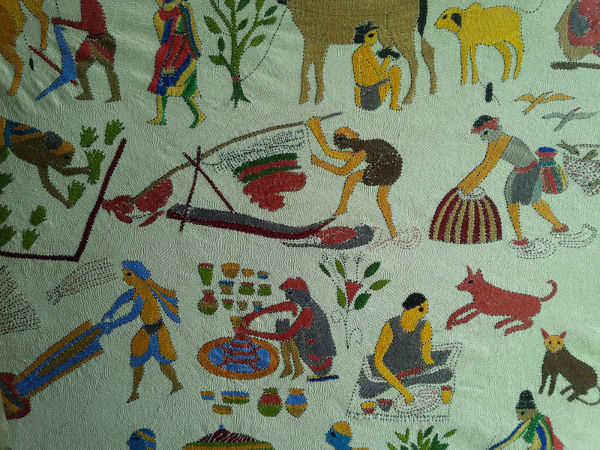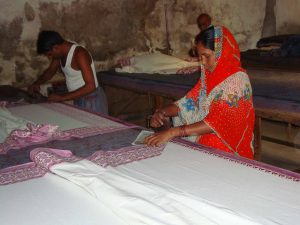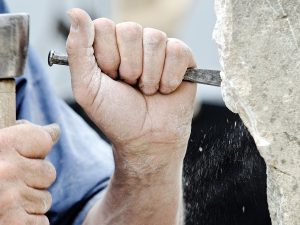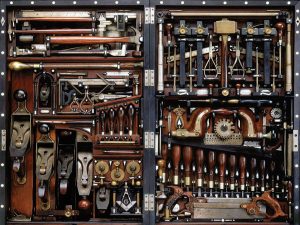The Future will be handmade? In the information age, the question has an absurd ring. But I ask after listening to Ashoke Chatterjee at the Artisans House in Mumbai. As a long time President of the Crafts Council of India, Chatterjee tells us that ‘The Future will be handmade’. The question mark is mine. After farming, the biggest form of employment in India is that of the artisan. We are told that about 200 million people make their livelihood as artisans. To compare, the number of workers in India’s famous IT industry may be a fraction of that but unlike them the largely rural based artisans are not a feature of the grand plans. Instead most artisans struggle with the lack of power.
Chatterjee recounts that, “At the Delhi gift fair, we see the exporters only. Hardly any of the artisans are allowed in. When invited for a craft conference in Vancouver, none of the Indian artisans got visas to travel. Through the compromise video conference, the artisans said, “We are not worried by rejection. We are used to it. But please just send us your orders“.” The holy city of Benares may be famous for its crafts but as Chatterjee noted, “Benares University has not honoured any weaver; they may be the greatest teachers but they have no degree”.
With this comes the thought that it wasn’t meant to be this way. Mahatma Gandhi’s proposed flag for India initially had a spinning wheel. To this day, the national flag may only be made with khadi, homespun cotton. Behind that, the march of progress has been another story.
But it’s the population demographics that Chatterjee refers to that really matter; it reminds me of Ivan Illich and his saying that “two-thirds of humankind still can avoid passing through the industrial age”. Illich wrote the celebrated book Tools for Conviviality based on the notion of a convivial society founded on the everyone’s right to self-defined work. Illich’s figures marry up with the reality that Chatterjee is describing. If we can consider the future as a ‘convivial future’, then the majority of humans in our stage of the 21st century, who make a living by small scale agricultural and artisanal work can at last enter the picture as architects of the future.

We have become aware of the urgency of other issues. Looking at the tapestries from Santiniketan, West Bengal, that I saw at the handloom expo in another Mumbai suburb, it’s a picture of society in which nature is integral. When we think of our ecological footprint and eroding carbon sinks, the picture becomes even more relevant to contemporary concerns. Then in a back-to-front way, given the crisis of work in industrialised countries and the increasing importance of the ‘creative sector’, this type of livelihood is a paradigm for the future. But the problem is that it hasn’t passed through the hoops of modernisation and integration into another value system, that of finance and technology that’s driving the progress. And that’s an obstacle to its evolution and even its existence.
Jacques Ellul, who coined the phrase Think Globally, Act Locally can partly explain this logic by going back to the early days of the Industrial revolution. In 1764, James Hargreaves had invented the Spinning Jenny to increase the production of yarn tenfold. More than the weavers at the time could ever handle. Thirty years later, Edmund Cartwright then invented the power loom. As Ellul points out in his book The Technological society, machines don’t work in isolation. Machines beget machines which re-fashion human labour into the way they work; into their modes of operations. We have the beginning of a sort of machinic eco-system. With capital investment, the more a machine’s technique is perfected, the more inventive it becomes in methods of pulling in the ‘non-producers’ (largely peasant farmers and artisans) to put them to work in its service. Which in its turn produces the consumers to drive the cycle. It’s the pattern of things that was and will be. The 18th century pattern thus is still in the 21st century. It’s of no surprise then to hear Ashoke Chatterjee speak of the constant pressure in India today to change legislation so that power looms can be added to hand looms for the bulk of the production process (save the last stage so retaining the hand crafted kitemark). For the artisans, this means both constant vigilance and resistance to preserve their livelihoods as they have no access to capital for expensive infrastructure.
Is it possible to think outside of this pattern of things, to break out of the chain reaction, without being anti-machine or anti-progress? To create machines for another version of progress based on self-defined work. Not so easy in this civilisation, Ellul argues, for ours is a civilisation of means, not of ends. When means are more important than ends, the multiplicity of means progressively reduce to the one: the most efficient. This closes down the range of possibilities. Invariably much of the conflict in our age is about that; whether they are dressed up in religious, tribal or ideological terms. In his talk, Chatterjee makes a passing reminder to the so-called Naxal corridors of India, the tribal forests and hinterlands where Naxalite Maoists are engaged in a bloody guerilla war. They are largely artisan based cultures whose livelihoods are threatened by ever advancing developers backed by large funds.

We are then referred to the image (taken from the talk) of the mother and child weaving a basket. What is going on in this picture Chatterjee asks? Someone mentions organic skills transfer – the little kid is learning. Of course but above all, the image represents ownership of the means of work. And it is work ‘at the point of need‘ without a need to migrate to the cities. But there are many who will worry about romanticising the image. I think of entrapment within the generational cycle, of enforced labour, lack of personal life choices. I have seen children working at looms when they could be at school. I recollect Herbert Read‘s writings on why our modern age is so different to the past; that freedom to choose who we want to be and want to do. Read himself was the son of an Yorkshire tenant farmer who went to university. His idea of a modern society was one that ‘guarantees the utmost equality while preserving individual freedoms, including the right of an individual to become detached from those community interests into which he or she had been accidentally projected by birth‘. That right of course surely applies here to the little child in the basket, his future.
If there are contradictions in how we see the image, they lie in why we read it in binary terms, not multidimensional possibilities. For when it comes to technology, it should be a case of what enables living realities. But that’s just not how it works, as history or circumstance for most part shows. So the real question facing us is whether the mother and child in the picture can develop their own opportunities to advance their lives and thus save themselves from being forced into the servile menial trades? In Mumbai, or Dubai, or so forth. Realistically that is the only means of progress offered to them. The route to be a part of the world of global labour and finance eager to draw them. Or it is possible to imagine another system of progress in the 21st century based on enablement, not exploitation.
Chatterjee points out that ‘the woman is wearing latex gloves. The poor have no phobia about about modernity and technology choices. If it is available they will use it‘. Certainly many now have shared use of cellphones, though it’s by no means universal, and that changed lives dramatically. Just like the village TV did a generation ago. In turn aspirations change. And that also affects the means of work and livelihood. As the activist-philosopher Franco Berardi argued, in the industrialised world, the cellphone has replaced the 70s office for many, a radical change in the idea of work. Through technology, whether we are now digital artisans, or traditional artisans, we come into a hitherto unknown common space, progressively on the same road to a Future. Much more so than in Marshall McLuhan’s 70’s ‘global village’ in that we are beginning to use global tools to interact, not just watching and consuming. The village TV is one thing but the village 3-D printer is another. If it’s made available to the artisans on the same terms as the handloom, the politics of technology, its hidden weave changes.

At the start of 20th century we were beholden to mass mechanised production. Today we are entranced with visions of a digitised world with new forms of making taking over. With both, the greater question is how will it matter? Without that, we have no means to address what we are going to be doing and how we are going to earn our daily bread.
In the 21st century then, artisanal objects are no longer the quiet pretty things we thought they were. Listening to Ashoke Chatterjee, I see something politically incendiary about them, through what he is saying though he doesn’t express it that way. It’s really the force of the statistical logic that is revolutionary as it implies a different means of progress for the 21st century than for the 20th. We understand that the 20th and the 19th centuries are unrepeatable in ecological terms but in what way? How the majority of humans are making a living today and how they enter the future has a lot to do with it.
Reblogged from Amplife.org – http://amplife.org/blog/future_handmade

























8 Comments
Hi Siraj,
I get your point that artisans don’t really feature in the plans of governments of developing countries, and they’re discriminated against at every turn. I guess that if they do feature in government or corporate plans at all, it’s to take away their artisan status and get them working in plantations or sweat shops – or if they’re lucky, telesales.
What do you see as the main problem – government policy, competition from the corporate sector, or technology itself? Does technology have its own dynamic, so that if businesses, including very small businesses, have to follow its dictates or die?
Actually, this is a loaded question, because I think your position is that it’s technology.
I agree that in a capitalist world of competing countries, governments and businesses don’t really have any other option than follow the dictates of technological efficiency. But what if we weren’t in a capitalist world of competing countries? Don’t you think systemic change could ‘tame’ technology?
And in fact, if we’re not talking about systemic change, how can the technology ever be tamed?
Dave
Artisan production is one thing that could help bring about change to the present system, and do it now. Although advocated by the Arts and Craft movement over a century ago when it was observed by some that the division of labour had taken the beauty out of craftsmanship, along with making workers miserable in factories because they were required to produce as much as possible for as little cost and therefore they could not excercise their creativity in work, I think this is truer today. Even 100 years ago it was noticed that goods were made to sell rather than be of any long-term use. But things have got much worse so that now, where I live, for example, it is often impossible to buy quality useful tools and other goods. We are in a consumer society and perhaps the system is undermining itself. Hence why artisan crafts are in demand. It is not technology to be tamed – it is how the technology is put to use.
I’ve had conversations with Siraj, and Dave King of Luddites200 and Breaking the Frame – and their position is that technology is not ‘put to use’, but we are ‘put to use’ by technology. It has a dynamic of its own, because if companies don’t use cutting edge technology, they die. So technology is laying down the rules of the game. It’s as if it’s evolving, using humans and our economic system to propel it to ever more complex levels, until (possibly), self-replicating robots in combination with artificial intelligence will just take the baton of evolution from us. I’m not sure this last part is Siraj’s stance, so I’d like to know what it is.
Interesting. I’m not sure that I agree with this though. Looking forward to hearing more, and discussing it in Derbyshire!
hi Dave,
it’s clear from what Ashoke Chatterjee is saying that these artisans are not anti-technology but for technology that enables and allow them to develop. As it is, the lives of the artisans, like that of agricultural workers is often harsh besides the power imbalance. I have seen how far they have to go to sell their wares. There are too many stories to tell. At the end of the talk there was discussion about the potential of the internet to help the artisans market their work and even talk of 3D printing to reduce the chores. Let’s say it’s about a different paradigm of technology, technology that actually enables the lives of the disempowered instead of harvesting them for another labour market.
Of that, as you say for most part.. if they’re lucky, telesales. The Bangladeshi writer and blogger Iftekhar Syeed writes “we are proud when one of our children becomes a cyber-coolie in the Empire”. But these days you could become a cyber coolie in Chingford or Chittagong. I am not sure it’s about developing nations as there is a convergence with the advanced economies with the global labour market.
On Monday I was at the launch of Nick Dyer-Witheford’s new book, Cyber-Proletariat, at an event called the Digital Barricades. He briefly outlined stats on current forms of employment that came with the collapse of the global peasantry sucked in by what he called the digital vortex. In terms of demographics, he told us that in 1980, there were 1.2 billion workers we could call the proletariat in the organised sector and the equivalent labour force of 30,000 robotic workers. In 2011, the same figures were 3 billion, 18 million respectively.
At the same time going by figures from Vijay Prasad’s last book, The Poorer Nations, in Western Europe 1970, there were 8 million unemployed, in 1994, it was 35 million. Clearly the combination of technology and transfer of work to emerging economies is creating what Prasad calls the disposable class – that vast explosion of precarious low wage work mainly in the service sector which is the only way to provide waged work. So all the technological progress and this is where we end up.
30 years from now, will our societies still be based on such work? And even if the dreams of the techno-utopians came true with AI and robotic labour, what exactly are we going to do?
We can argue for the post-capitalist, post-human and so forth but I don’t often hear the kind of joined-up thinking that grows out of demographic reality – that most people on the planet still earn their livelihood through agricultural and artisanal work. Which needs a reality-check to integrate all our talk about technology and politics.
What I took from Ashoke Chatterjee’s talk was a vision of a future based on paradigms of work that exist and sustains livelihoods for most humans. It isn’t just labour, but embedded social, real and imaginary, ecological, human and natural relationships. There are massive uncalculated costs in destroying this huge labour reserve for predictable reasons as it’s a resource in the same way as the Amazon forest or the Arctic ice cap.
So ‘convivial’ technology then, as Ivan Illych would say – i.e. technology that decentralises (solar panels, 3-D printing, open source, natural building materials etc.) rather than centralises (nuclear power, cement etc.)?
Yes, I don’t think the transfer of work to robots and AI is going to help most people if they don’t own the technology.
I think a lot more people would make their living as artisans or smallholders if they could, but the global capitalist economy makes that very different. I used to live next door to a builder, and I didn’t really try to talk to him about this kind of thing, until one day he said that he hated his job, and really, all he wanted to do was have 5 acres somewhere to feed himself and his family, and to build his own house (which he was perfectly capable of doing), and to do a bit of building work on the side for pocket money. Good luck with that.
And a lot of people (some of whom are supposedly anti-corporate) complain that small businesses or self-empoyed people producing artisan goods or organic food charge too much, and therefore it’s only fluffy stuff for middle-class people. I don’t buy this – the stuff we buy, including food, is so cheap because people in poor countries and the environment are made to pay. Really, that’s the price that good food and products should be.
A lot of people are happy to spend £150 on trainers but complain if they have to pay a reasonable price for food.
The big question of course is: what are we going to do about it?
Regarding convivial tools, society today, including the parts of it aspiring to autonomy, is defined by tools like computers, cellphones, visa cards etc that are only produced by large entities, be they be States, or corporations. Empowering the artisans means enabling access to these tools. Of course that means increasing demand for such tools which, as it is, means more of those militarised megafactories where they are made. Like Foxconn in Taiwan with its human worker bees and high suicide rates. More factories means need for more labour.
I need to use a computer and I need to go online but thankfully I don’t have to work in a SEZ or Foxconn factory. We are stuck in a paradigm of production because the competition is so cut-throat and the demand for profit unrelenting. Somehow then I would prefer the production of such tools using robots rather than humans. Machines making machines. I would consider that potentially convivial but I wouldn’t see it as autonomous. But for that scenario, going by Nick Dyer-Witheford’s figures we would need another exponential rise in the number of working robots or automated production to avoid condemning more people to such work or prevent their co-option in other forms of soulless work we have yet to imagine.
To get around all this, maybe communitarians will argue for technology that enables them to produce or part-produce such digital tools autonomously but that will need a further technological leap. Decentralised full spectrum autonomy with technology will always be a tall order. Maybe a community can then produce a cell phone but what about the network?
My post comes out of the reality of the existing demographics of artisanal work today and its value in the 21st century thanks to Ashoke Chatterjee. Why it’s a paradigm for the future. For that it has to dovetail with enabling digital technologies. Thus the question mark. But in fact in China, the crafts are now classified as a ‘sunrise’ industry along with IT because China has reached a sort of manufacturing tipping point. In India however, particularly now with the land-acquisition bill and a pro-business government enabling large commercial interests to buy land more easily, the artisans often in tribal areas are an ‘obstacle’ to economic growth. Ashoke Chatterjee called it a ‘sunset’ scenario. And this is the case in many other emerging economies. But it’s short-sighted with the longer future in mind.
Regarding comparative prices of sustainable food and trainers, I get the point but we are going through a time with food banks, and austerity. Many people are doing without. Maybe it needs a new post to make the case.
All good points – but if everything is made by machines, who owns the machines? Won’t it just strengthen the grip of corporations on the global economy, which in turn will make society that bit less democratic and sustainable?